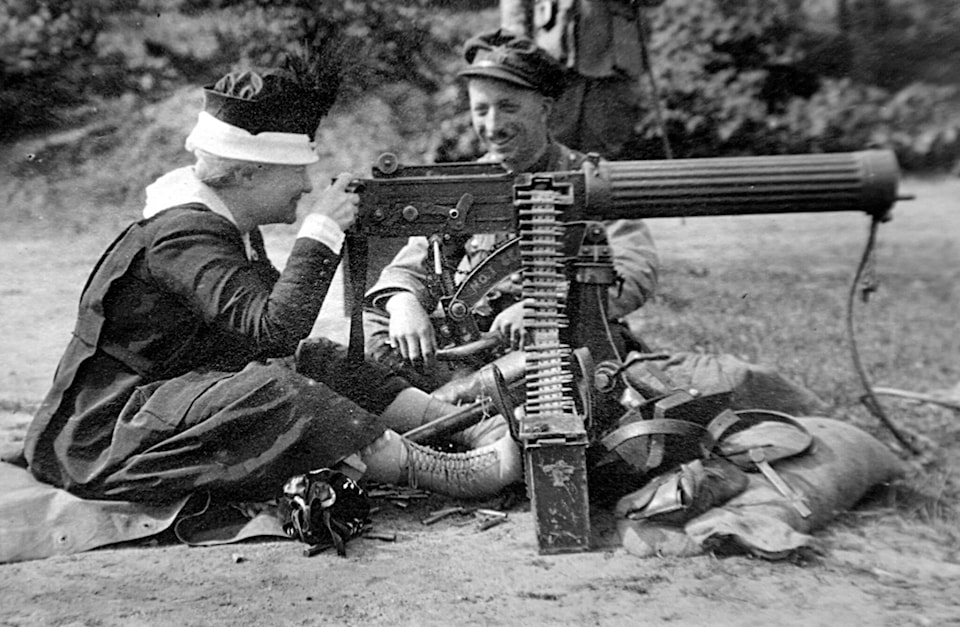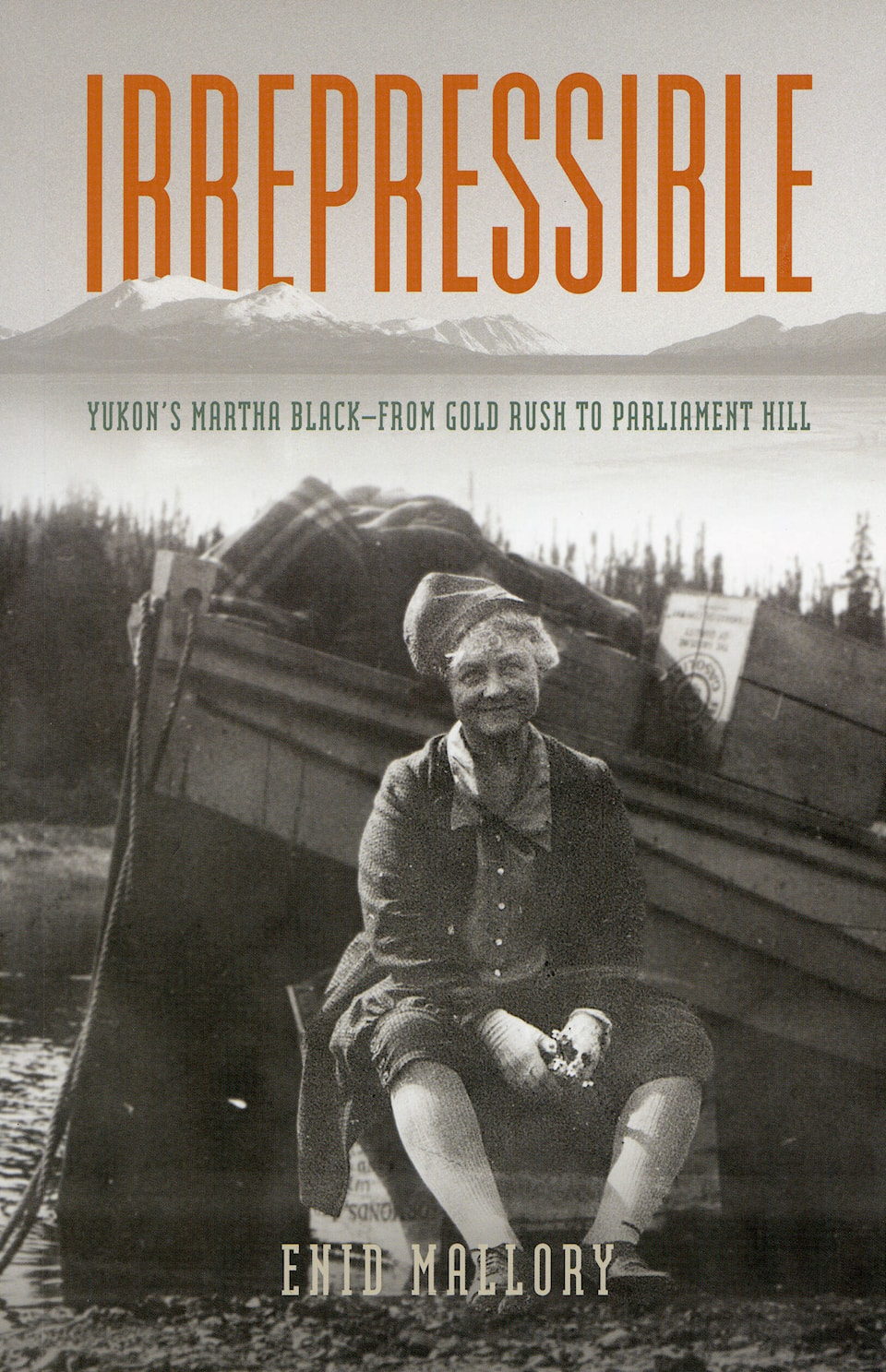A new book arrived on my desk recently: Irrepressible: Yukon’s Martha Black — From Gold Rush to Parliament Hill by Enid Mallory, published by Hancock House. Given my positive appraisal of her previous book, Under the Spell of the Yukon (Heritage House, 2006), about Robert Service, I was looking forward to reading this new account.
Martha’s career was filled, from start to finish, with remarkable adventures and notable achievements, and this is what Enid Mallory has aimed at in this account of Martha Black’s interesting life. In Martha’s own words: “What I wanted was not shelter and safety, but liberty and opportunity.” Mallory takes the reader through the phases of Martha Black’s career using appropriate passages and reflections upon Black’s accomplishments while interspersing the narrative with insightful observations of her own, in which she succeeds in revealing Martha Black’s irrepressible spirit.
There is no denying that Martha Black was an exceptional woman. Martha Louise Munger was born into a wealthy Chicago family in February 1866. She was raised in comfort and privilege, and her schooling ensured her proper deportment if she were ever to take tea in the White House.
Martha married Will Purdy, the son of another wealthy family, and over the next 11 years, they produced three sons — Warren, Donald and Lyman. Lyman was born in a log cabin across the river from Dawson City in January of 1899, by which time Martha and her husband had separated for good. Martha Black never saw Will Purdy again, and George Black was the only father that Lyman ever knew. Martha participated in the Klondike stampede, climbing the Chilkoot Pass like so many others and making her way to the Klondike.
Over the following years, she managed a sawmill in Dawson and met and eventually married (in 1904) George Black, a prominent Dawson lawyer originally from New Brunswick. Martha converted to George’s nationality (he saw himself as British as much as Canadian), his religion (Church of England) and his politics (Conservative). Over the following five decades, they established an effective political machine in the territory. By the 1930s, the two acknowledged political parties in the Yukon were “the Liberals and the Blacks.”
During the first 10 years of the 20th Century, George and Martha became imbedded in Dawson social life. They nurtured Martha’s three sons. They shared their love of the outdoors: He hunted and took photographs, and she collected specimens of Yukon wildflowers. In the years that followed, Martha collected hundreds of specimens of Yukon wildflowers, sending them to various institutions abroad.
George spent three terms on the territorial council before relocating his law practice to Vancouver, but he did not remain in the south for long. In early 1912, thanks to his involvement in the recent election and the Conservative win in parliament, George was rewarded with the appointment as Yukon commissioner (essentially the chief administrator for the Yukon). The Blacks moved into Government House, with Martha as chatelaine. From gold rush stampeders, they had become elevated to the premier citizens in the territory.
All of that came to an end after Britain declared war upon Germany in 1914, and George subsequently secured a commission in the Canadian Overseas Expeditionary Force (CEF). Martha accompanied George to London and while he prepared to go into battle, Martha served in various volunteer capacities in support of the war effort. Shortly after they arrived in London, Martha was made a Fellow of the Royal Geographical Society for her work with Yukon wildflowers.
George’s position as commissioner of the Yukon was abolished before he returned from the war, so the Blacks settled in Vancouver, where he could practice law, but not for long. George was called to run for the Conservatives in the Yukon in the 1921 federal election. He was elected and re-elected several times before being appointed Speaker of the House of Commons in 1930. During the following years, Martha and George led a nomadic life, moving between Ottawa, Dawson City and Vancouver, but never settling anywhere for more than a few months.
George and Martha travelled extensively while he was Speaker and entertained, or were entertained by, many prominent dignitaries from Canada and abroad. When George was unable to run in the 1935 federal election due to his health, Martha stepped in and was elected in his place, only the second woman ever elected to the House of Commons. She held the seat until George returned to politics in 1940.
This book is an easy and entertaining read, illustrated with 34 well-curated photos, though the quality of the reproduction of these images by the printer leaves much to be desired. No map accompanies the text in this volume.
The author employs her love of Yukon history to add colour and context to her narrative, using her personal knowledge of such luminaries as Robert Service and, to a lesser extent, Joe Boyle. Yet, at the same time, it is some of the contextual details where the reader might be led astray. Yes, Martha Black lived in Lousetown for a while, but the prostitutes did not move there until a couple of years after her departure.
On page 63, she likens the commissioner’s role to that of a province’s lieutenant governor. That may be an accurate description today, but in George Black’s time, the position was more like a governor or CEO than the contemporary figurehead. In the early days of the Klondike, the big Canadian holiday was the Queen’s birthday, rather than July 1st, as stated on page 66.
Yet Mallory has captured the social milieu that prevailed in Dawson in the days following the gold rush, and that goes a long way to understanding why Martha Black was such a presence in the Dawson social scene.
Mallory’s book follows in the footsteps of many other Martha Black biographers, relying too heavily upon Martha’s own account of her life. But if you haven’t read about the life of Martha Black before, this might be a good place to start, or you may choose to refer to Black’s autobiography, and get it from the horse’s mouth.
Irrepressible: Yukon’s Martha Black — From Gold Rush to Parliament Hill is 160 pages long, with endnotes (three pages) and a bibliography (two pages). It is published by Hancock House Publishers and sells for $24.95.
Michael Gates was the Yukon’s first Story Laureate from 2020 to 2023. His latest book, “Hollywood in the Klondike,” is now available in Whitehorse stores. You can contact him at msgates@northwestel.net

